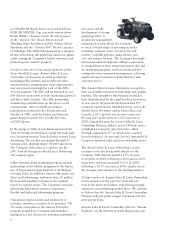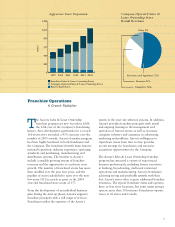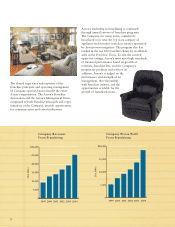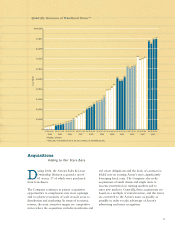Aarons 2004 Annual Report Download - page 16
Download and view the complete annual report
Please find page 16 of the 2004 Aarons annual report below. You can navigate through the pages in the report by either clicking on the pages listed below, or by using the keyword search tool below to find specific information within the annual report.
14
and an accrued revenue receivable net of allowance for
doubtful accounts based on historical collection rates of
approximately $4.1 million and $3.0 million, respectively.
Revenues from the sale of merchandise to franchisees are
recognized at the time of receipt by the franchisee, and
revenues from such sales to other customers are recognized
at the time of shipment.
Rental Merchandise
Our sales and lease ownership division depreciates mer-
chandise over the agreement period, generally 12 to 24
months when rented, and 36 months when not rented, to
0% salvage value. Our rent-to-rent division depreciates
merchandise over its estimated useful life, which ranges from
six months to 60 months, net of salvage value, which ranges
from 0% to 60%. Sales and lease ownership merchandise is
generally depreciated at a faster rate than our rent-to-rent
merchandise. As sales and lease ownership revenues continue
to comprise an increasing percentage of total revenues,
we expect rental merchandise depreciation to increase
at a correspondingly faster rate.
Our policies require weekly rental merchandise counts by
store managers and write-offs for unsalable, damaged, or
missing merchandise inventories. Full physical inventories are
generally taken at our fulfillment and manufacturing facilities
on a quarterly basis with appropriate provisions made for
missing, damaged and unsalable merchandise. In addition,
we monitor rental merchandise levels and mix by division,
store and fulfillment center, as well as the average age of
merchandise on hand. If unsalable rental merchandise cannot
be returned to vendors, its carrying value is adjusted to net
realizable value or written off. All rental merchandise is
available for rental and sale.
Effective September 30, 2004, we began recording rental
merchandise carrying value adjustments on the allowance
method, which estimates the merchandise losses incurred
but not yet identified by management as of the end of the
accounting period. Previously, we accounted for merchandise
inventory adjustments using the direct write-off method,
which recognized merchandise losses only after they were
specifically identified. This adoption of the allowance
method had the effect of increasing expenses in the third
quarter of 2004 for a one-time adjustment of approximately
$2.5 million to establish a rental merchandise allowance
reserve on our balance sheet. We expect rental merchandise
adjustments in the future under this new method to be
materially consistent with the prior years’ adjustments under
the direct write-off method. Rental merchandise adjustments,
including the effect of the establishment of the reserve
mentioned above, totaled approximately $18.0 million,
$11.9 million, and $10.1 million during the years ended
December 31, 2004, 2003, and 2002, respectively.
Leases and Closed Store Reserves
The majority of our Company-operated stores are operated
from leased facilities under operating lease agreements. The
substantial majority of these leases are for periods that do
not exceed five years. Leasehold improvements related to
these leases are generally amortized over periods that do
not exceed the lesser of the lease term or five years. While a
majority of our leases do not require escalating payments, for
the leases which do contain such provisions we record the
related lease expense on a straight-line basis over the lease
term. Finally, we do not generally obtain significant amounts
of lease incentives or allowances from landlords. The total
amount received in 2004, 2003, and 2002 totaled approxi-
mately $1.3 million, $.6 million, and $.4 million, respective-
ly. Such amounts are recognized ratably over the lease term.
From time to time, we close or consolidate retail stores.
We record an estimate of the future obligation related to
closed stores based upon the present value of the future
lease payments and related commitments, net of estimated
sublease income which we base upon historical experience.
At each of the years ended December 31, 2004 and 2003,
our reserve for closed stores was $2.2 million. If our
estimates related to sublease income are not correct,
our actual liability may be more or less than the liability
recorded at December 31, 2004.
Insurance Programs
Aaron Rents maintains insurance contracts to fund
workers compensation and group health insurance claims.
Using actuarial analysis and projections, we estimate the
liabilities associated with open and incurred but not reported
workers compensation claims. This analysis is based upon
an assessment of the likely outcome or historical experience,
net of any stop loss or other supplementary coverages. We
also calculate the projected outstanding plan liability for our
group health insurance program. Effective September 30,
2004, we revised certain estimates related to our accrual for
group health self-insurance based on our experience that the
time periods between our liability for a claim being incurred
and the claim being reported had declined and on favorable
claims experience which resulted in a reduction in expenses
of $1.4 million for the nine-month period ended September
30, 2004. Our liability for workers compensation insurance
claims and group health insurance was approximately $3.2
million and $3.8 million at the years ended December 31,
2004 and 2003, respectively.
If we resolve existing workers compensation claims for
amounts that are in excess of our current estimates and
within policy stop loss limits, we will be required to pay
additional amounts beyond those accrued at December 31,
2004. Additionally, if the actual group health insurance
liability exceeds our projections, we will be required
to pay additional amounts beyond those accrued at
December 31, 2004.
The assumptions and conditions described above reflect
management’s best assumptions and estimates, but these
items involve inherent uncertainties as described above,
which may or may not be controllable by management. As a
result, the accounting for such items could result in different
amounts if management used different assumptions or if dif-
ferent conditions occur in future periods.
Same Store Revenues
We refer to changes in same store revenues as a key
performance indicator. For the year ended December 31,
2004, we calculated this amount by comparing revenues as
of December 31, 2004 and 2003 for all stores open for the
entire 24-month period ended December 31, 2004, excluding
stores that received rental agreements from other closed
or merged stores. For the year ended December 31, 2003,
we calculated this amount by comparing revenues as of
December 31, 2003 and 2002 for all stores open for the
entire 24-month period ended December 31, 2003, excluding
stores that received rental agreements from other closed or
merged stores.
























